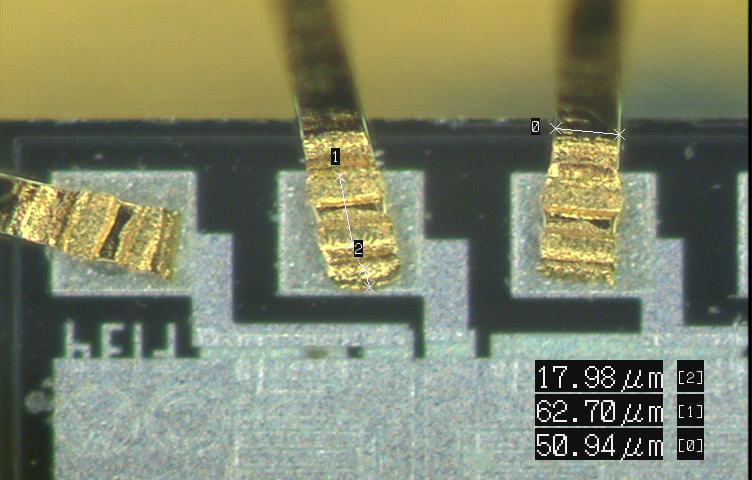As frequencies go up in traditional hybrid and optoelectronic packaging, the first level wire interconnect itself can become a problem. The main issue is reactive inductance, but reactive capacitance can be a problem as well. Changing the shape of the wire from round to ribbon can directly affect the main problem – reactive inductance.
Benefits of Ribbon Bonding
At frequencies above ~20-21 GHz, ribbon wire behaves much better than round wire electrically. The benefits never end – the higher the frequency, the more important it is to use ribbon wire. At ~100 GHz+, even ribbon wire becomes a problem. The higher the frequency, the shorter the wire needs to be for the circuit to behave the way it is designed. Therefore, we are focusing on packages that have at least some content that works in the ~20-100 GHz frequency range.
.jpg?width=398&height=254&name=ribbon_bonding-blog(2).jpg)
There are distinct operational benefits associated with ribbon bonding, but there are benefits of near equal importance – consider Cpk, or process capability of the actual wire bonding. Force is applied over a square area versus a line with round wire. This is a more gentle application and it reduces the incidence of cratering. In many cases, the ribbon wire is only ½ mil thick and the amount of deformation is minimal, allowing for finer pitch applications and even more important – smaller pad sizes.
When you generate the first bond, the rectangular nature of the wire firmly sets the wire so that it will tend to not sway. This allows for even better looping control, and that can play into reducing reactive capacitance and shortening the wire. Additionally, a shorter wire has less reactive inductance. It is interesting how mechanical features can have so many beneficial electrical effects. That is what keeps this business interesting!
that it will tend to not sway. This allows for even better looping control, and that can play into reducing reactive capacitance and shortening the wire. Additionally, a shorter wire has less reactive inductance. It is interesting how mechanical features can have so many beneficial electrical effects. That is what keeps this business interesting!
Tail control is also improved when using ribbon wire. The clamping mechanism has a larger and flatter area that improves clamp functionality and tail length repeatability. This is a critical aspect of wedge bonding in general, as it is the first process of many that affects the overall wire interconnect.
With a more repeatable (and shorter) tail length, you can generate a more repeatable (and smaller by deforming less) first bond. With a more repeatable first bond, you can generate a more repeatable loop. The loop profile interacts with the formation of the second bond so a more repeatable loop assists in generating a more repeatable second bond. With a more repeatable second bond, you can create a more repeatable tail. Then it is done all over again. This creates one nice circle of benefits, and it starts by changing the shape of the wire to ribbon so that clamping is improved!
Ribbon Bonding Expertise
Palomar Technologies has been delivering automated ribbon bonding solutions for decades. The Palomar/Hughes 2470 enjoyed five versions with many machines still in the field. Palomar has continued to develop ribbon bonding expertise. We encourage you to come visit us SEMICON West in booth #5952 to learn more.

For more on ribbon bonding, download the paper "Benefits of Automated Ribbon Bonding for Microwave Applications" or the "Automated Ribbon Bonding" article.
----
Bradley K. Benton
Regional Account Manager, Western Americas
Palomar Technologies, Inc.

